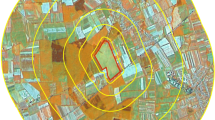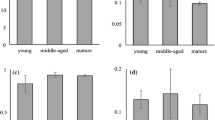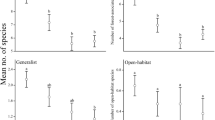Abstract
Background and Aims
Soil texture is an important determinant of ecosystem structure and productivity in drylands, and may influence animal foraging and, indirectly, plant community composition.
Methods
We measured the density and composition of surface disturbances (foraging pits) of small, soil-foraging desert vertebrates in shrubland and grasslands, both with coarse- and fine-textured soils. We predicted that the density and functional significance of disturbances would be related more to differences in texture than shrub encroachment.
Results
Soil texture had a stronger influence on animal foraging sites than shrub encroachment. There were more disturbances, greater richness and abundance of trapped seed, and greater richness of germinating plants on coarse- than fine-textured soils. Pits in coarse soils trapped 50 % more litter than those in finer soils. Apart from slightly more soil removal and greater litter capture in shrubland pits, there were no effects of encroachment.
Conclusions
Although the process of woody encroachment has been shown to have marked effects on some ecosystem properties, it is likely to have a more subordinate effect on surface disturbances and therefore their effects on desert plant communities than soil texture. Our results highlight the importance of animal activity in shaping desert plant communities, and potentially, in maintaining or reinforcing shrub dominant processes.



Similar content being viewed by others
References
Anderson MJ, Gorley RN, Clarke KR (2008) PERMANOVA + for PRIMER: guide to software and statistical methods. PRIMER-E, Plymouth
Bardgett RD, Wardle DA (2010) Aboveground-belowground linkages: biotic interactions, ecosystem processes, and global change. Oxford University Press, New York
Bucini G, Hanan NP (2007) A continental scale analysis of tree cover in African savannas. Global. Ecol Biogeogr 16:593–605
Burke IC, Elliott ET, Cole CV (1995) Influence of macroclimate, landscape position, and management on soil organic-matter in agroecosystems. Ecol Appl 5:124–131
Byers JE, Cuddington K, Jones CG, Talley TS, Hastings A, Lambrinos JG, Crooks JA, Wilson WG (2006) Using ecosystem engineers to restore ecological systems. TREE 21:493–500
Dodd MB, Lauenroth WK, Burke IC, Chapman PL (2002) Associations between vegetation patterns and soil texture in the shortgrass steppe. Plant Ecol 158:127–137
Eldridge DJ, James AI (2009) Soil-disturbance by native animals plays a critical role in maintaining healthy Australian landscapes. Ecol Manag Restor 10:S27–S34
Eldridge DJ, Whitford WG (2009) Soil disturbance by native animals along grazing gradients in an arid grassland. J Arid Environ 73:1144–1148
Eldridge DJ, Whitford WG, Duval BD (2009) Animal disturbances promote shrub maintenance in a desertified grassland. J Ecol 97:1302–1310
Eldridge DJ, Bowker MA, Maestre FM, Roger E, Reynolds JF, Whitford WG (2011) Impacts of shrub encroachment on ecosystem structure and functioning: towards a global synthesis. Ecol Lett 14:709–722
Giannoni SM, Dacar M, Taraborelli P, Borghi CE (2001) Seed hoarding by rodents of the Monte Desert Argentina. Austral Ecol 26:259–263
Gibbens RP, Hicks RA, Dugas WA (1996) Structure and function of C-3 and C-4 Chihuahuan Desert plant communities. Standing crop and leaf area index. J Arid Environ 34:47–62
Gibbens RP, McNeely RP, Havstad KM, Beck RF, Nolen B (2005) Vegetation changes in the Jornada Basin from 1858 to 1998. J Arid Environ 61:651–668
Havstad KM, Huenneke LF, Schlesinger WH (2006) Structure and function of a Chihuahuan Desert ecosystem. The Jornada basin long-term ecological research site. Oxford University Press, Oxford
Hernandez L, Romero AG, Laundre JW, Lightfoot D, Aragon E, Portillo JL (2005) Changes in rodent community structure in the Chihuahuan Desert Mexico: comparisons between two habitats. J Arid Environ 60:239–257
Hoover KD, Whitford WG, Flavill P (1977) Factors influencing the distributions of two species of Perognathus. Ecology 58:877–884
James AI, Eldridge DJ (2007) Reintroduction of fossorial native mammals and potential impacts on ecosystem processes in an Australian desert landscape. Biol Conserv 138:351–359
James AI, Eldridge DJ, Hill BM (2009) Foraging animals create fertile patches on an Australian desert shrubland. Ecography 32:723–732
James AI, Eldridge DJ, Koen TB, Moseby KE (2011) Can the invasive European rabbit (Oryctolagus cuniculus) assume the soil engineering role of locally-extinct natives? Biol Invasive 13:3027–3038
Johnson RA (1992) Soil texture as an influence on the distribution of the desert seed-harvester ants Pogonomyrmex-rugosus and Messor-pergandei. Oecologia 89:118–124
Kerley GIH, Whitford WG (2000) Impact of grazing and desertification in the Chihuahuan Desert: plant communities, granivores and granivory. Am Midl Nat 144:78–91
Kerley GIH, Whitford WG, Kay FR (1997) Mechanisms for the keystone status of kangaroo rats: graminivory rather than granivory? Oecologia 111:422–428
Krasnov BR, Shenbrot GI, Rios LE, Lizurume ME (2000) Does food-searching ability determine habitat selection? Foraging in sand of three species of gerbilline rodents. Ecography 23:122–129
Lane SN, Reaney SM, Heathwaite AL (2009) Representation of landscape hydrological connectivity using a topographically driven surface flow index. Water Resour Res 45:WO8423
Li M, Li Z, Yao W, Liu P (2009) Estimating the erosion and deposition rates in a small watershed by the Cs-137 tracing method. Appl Radiat Isot 67:362–366
Muñoz A, Bonal R, Díaz M (2009) Ungulates, rodents, shrubs: interactions in a diverse Mediterranean ecosystem. Basic Appl Ecol 10:151–160
Nagorsen DW, Museum RBC (2005) Rodents and Lagomorphs of British Columbia. Royal BC Museum
Nieminen JK (2008) Soil animals and ecosystem processes: how much does nutrient cycling explain? Pedobiol 51:367–373
Noy-Meir I (1979) Structure and function of desert ecosystems. Israel J Bot 28:1–19
Parker LW, Miller J, Steinberger Y, Whitford WG (1983) Soil respiration in a Chihuahuan desert rangeland. Soil Biol Biochem 15:303–309
Parmenter RR, MacMahon JA (1983) Factors determining the abundance and distribution of rodents in a shrub-steppe ecosystem - the role of shrubs. Oecologia 59:145–156
Payne RW, Harding SA, Murray DA, Soutar DM, Baird DB, Glaser AI, Channing IC, Welham SJ, Gilmour AR, Thompson R, Webster R (2008) The guide to GenStat release 11, Part 2: statistics. VSN International, Hemel Hempstead, United Kingdom
Payne RW, Lane PW, Digby PGN, Harding SA, Leech PK, Morgan GW, Todd AD, Thompson R, Tunnicliffe Wilson G, Welham SJ, White RP (1993) Genstat 5 Release 3 Reference Manual. Oxford University Press, New York
Price MV, Podolsky RH (1989) Mechanisms of seed harvest by heteromyid rodents - soil texture effects on harvest rate and seed size selection. Oecologia 81:267–273
Price MV, Reichman OJ (1987) Distribution of seeds in Sonoran desert soils - implications for Heteromyid rodent foraging. Ecology 68:1797–1811
Pyare S, Longland WS (2000) Seedling-aided cache detection by heteromyid rodents. Oecologia 122:66–71
Reichman OJ (1979) Desert granivore foraging and its impact on seed densities and distributions. Ecology 60:1085–1092
Reichman OJ (1984) Spatial and temporal variation of seed distributions in Sonoran Desert soils. J Biogeogr 11:1–11
Reichman OJ (1988) Caching behavior of eastern wood rats Neotoma floridana in relations to food perishability. Anim Behav 36:1525–1532
Rosenzweig ML, Winakur J (1969) Population ecology of desert rodent communities: habitats and environmental complexity. Ecology 50:558–572
Roth GA, Whitford WG, Steinberger Y (2007) Jackrabbit (Lepus californicus) herbivory changes dominance in desertified Chihuahuan desert ecosystems. J Arid Environ 70:418–426
Schoener TW (1971) Large-billed insectivorous birds - precipitous diversity gradient. Condor 73:154–161
Schooley RL, Bestelmeyer BT, Kelly JF (2000) Influence of small-scale disturbances by kangaroo rats on Chihuahuan Desert ants. Oecologia 125:142–149
Sivy KJ, Ostoja SM, Schupp EW, Durham S (2011) Effects of rodent species, seed species, and predator cues on seed fate. Acta Oecol 37:321–328
Smit C, Vandenberghe C, den Ouden J, Mueller-Schaerer H (2007) Nurse plants, tree saplings and grazing pressure: changes in facilitation along a biotic environmental gradient. Oecologia 152:265–273
Stapp P, van Horne B (1997) Response of deer mice (Peromyscus maniculatus) to shrubs in shortgrass prairie: linking small-scale movements and the spatial distribution of individuals. Funct Ecol 11:644–651
Throop H, Archer S (2009) Resolving the dryland decomposition conundrum: some new perspectives on potential drivers. Progress in Botany. In: U. Lüttge, W. Beyschlag, B. Büdel, D. Francis (eds), pp. 171–194. Springer Berlin Heidelberg
Throop HL, Archer SR (2007) Interrelationships among shrub encroachment, land management and litter decomposition in a semidesert grassland. Ecol Appl 17:1809–1823
Travers SK, Eldridge DJ, Koen SB, Soliveres S (2012) Animal foraging pit soil affects the growth of a native grass. Plant Soil 352:341–351
Whitford WG (2002) Ecology of desert systems. Elsevier Science, London
Whitford WG, Kay FR (1999) Biopedturbation by mammals in deserts: a review. J Arid Environ 41:203–230
Woinarski JCZ, Palmer C, Fisher A, Southgate R, Masters P, Brennan K (1999) Distributional patterning of mammals on the Wessel and English Company islands Arnhem Land, Northern Territory, Australia. Aust J Zool 47:87–111
Acknowledgments
We acknowledge support from the International Arid Lands Consortium, thank Terry Koen for undertaking the statistical analyses, and Santiago Soliveres, Matthew Bowker and Heather Throop for comments on earlier drafts. Chris Havstad provided office space to DJE while this work was carried out. This is a contribution to the Jornada Long–Term Ecological Research Program.
Author information
Authors and Affiliations
Corresponding author
Additional information
Responsible Editor: Jeffrey Walck .
Electronic supplementary material
Below is the link to the electronic supplementary material.
Appendix S1
(DOCX 623 kb)
Appendix S2
(DOCX 27 kb)
Appendix S3
(DOCX 27 kb)
Appendix S4
(DOCX 26 kb)
Appendix S5
(DOCX 27 kb)
Rights and permissions
About this article
Cite this article
Eldridge, D.J., Whitford, W.G. Disturbances by desert rodents are more strongly associated with spatial changes in soil texture than woody encroachment. Plant Soil 381, 395–404 (2014). https://doi.org/10.1007/s11104-014-2142-5
Received:
Accepted:
Published:
Issue Date:
DOI: https://doi.org/10.1007/s11104-014-2142-5




